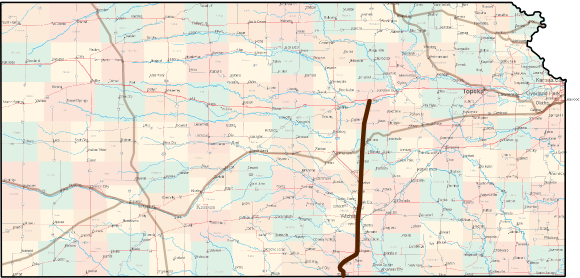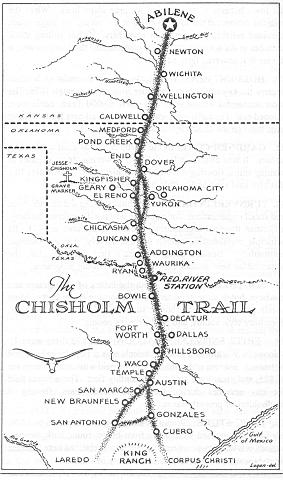In the 20-year span from 1867 to 1887 over 5 million head of cattle traveled up the Chisholm Trail from Texas to the railroads in the cattle towns of Kansas. Through about 1871, the end of the trail was Abilene, but as the railroads expanded, the end of the trail moved southward to Newton, Wichita, and Caldwell. By then, the trail had witnessed "the greatest migration of livestock in world history".

There is currently no "official" Chisholm Trail Bicycle Route in Kansas, but you can follow the approximate route by taking K-49 north from Caldwell, US-160 east to Wellington, north on US-81 through Wichita, north on Broadway/2nd St/Kansas Rd to Newton, north on K-15, east on US-56 to Hillsboro, and finally north on K-15 to Abilene.
Communities Along the Chisholm Trail
About the Chisholm Trail
The Chisholm Trail extended from Texas north to Abilene, Kansas, and over the course of about 20 years, starting in 1867, carried approximately 5 million head of cattle to railroad towns and then to markets east.
When the Civil War drew to a close the plains of Texas were swarming with cattle for which there was no ready market. Herds of cattle were offered for sale upon the range at one to two dollars per head without finding a buyer. So critical did the situation become that Joseph G. McCoy, prominent cattleman of the time, was led to remark, "–there dawned a time in Texas that a man's poverty was estimated by the number of cattle he possessed."But the situation in the North was quite different. A good animal which would bring only a few dollars in Texas would sell for as much as ten times that amount in the North. [2] Prior to the Civil War there had been attempts to drive Texas cattle to market, but never on a very large scale.
After the Civil War, towns in southwestern Missouri and southeastern Kansas were the destinations of these early drives. It was not, however, until the railroads began to move westward that the movement was to reach its height. The North was demanding the meat which already existed in Texas. The big problem was to find a connecting link, and in this fact we see the beginnings of the Chisholm trail.
Joseph G. McCoy, a cattle buyer of Illinois, heard of the conditions in Texas and determined to see what he could do to remedy them. He came to Abilene in 1867, which was, as he describes it, ". . . a small dead place, consisting of about a dozen log huts, low, small rude affairs, four fifths of which were covered with dirt for roofing," and determined to establish a cattle terminal there.
The Kansas Pacific Railway had already extended its lines to this place, and McCoy decided that if the proper shipping facilities were set up it would be a comparatively easy matter for the Texas ranchers to drive their cattle overland to market.
Read more from The Chisholm Trail by John Rossel. Chisholm Trail Historic Map courtesy of the Dickinson County Historical Society.
Learn more about the Chisholm Trail
- Chisholm Trail Museum
- LegendsOfAmerica.com
- TheChisholmTrail.com
- The Chisholm Trail Heritage Museum
- Wikipedia



